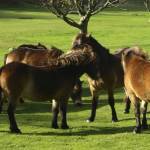What Makes a Horse an Easy Keeper?

Members of certain breeds are notoriously easy keepers—they readily put on and maintain weight, often to the point of obesity, putting them at risk for metabolic disorders. The mechanisms responsible for making certain horses easy keepers—and others not—remain unclear, yet new data show that enhanced feed digestibility does not appear to be a contributing factor.*
“Digestibility is a measure of nutrient availability and refers to the amount of nutrients digested and absorbed by the horse. Digestibility is measured during controlled feeding studies and calculated as the difference between the amount of nutrient consumed and the amount of nutrient expelled in feces,” explained Catherine Whitehouse, M.S., a Kentucky Equine Research nutritionist.
If easy keepers are able to derive more energy from the same feed compared to medium or hard keepers, then this may explain their tendency to become overweight. Improved digestibility could also explain why easy keepers often thrive on low-quality but hygienic forage while medium and hard keepers cannot.
To test the theory that easy keepers have enhanced digestibility, horses and ponies were fed various diets, and total tract digestibility was measured. Andalusians and ponies were included in this study as they are generally considered easy keepers. Standardbreds were selected for comparison because they are relatively insulin sensitive and not classified as easy keepers.
The horses and ponies were fed one of three diets: (1) a high-fiber diet that met estimated energy requirements; (2) a high-carbohydrate (cereal-rich) diet designed to exceed energy requirements; and (3) a high-fat diet formulated to exceed energy requirements and induce weight gain.
To measure digestibility, total feed intake was measured, and total fecal outputs were collected in a 24-hour period while horses were maintained in individual stalls. All samples were analyzed by a commercial laboratory to measure:
- Gross (total) energy: the number of calories in the feed;
- Dry matter: total nutrient content after removal of water;
- Neutral detergent fiber: a collective measure of the structural carbohydrates cellulose, hemicellulose, and lignin;
- Starch: a nonstructural carbohydrate and the main energy store of plants; and
- Crude protein and crude fat.
Digestibility was calculated as a percent of intake versus excretion.
“For example, if a horse consumes 1,295 g of crude protein per day from hay and feed and 500 g of crude protein is measured in feces. The difference between intake and output is calculated and then divided by the total intake to calculate the proportion of nutrients digested and absorbed. In this example, the apparent digestibility of crude protein is 61%,” Whitehouse explained. Alternatively, if a horse has 750 g of crude protein in their feces, the digestibility is only 42%.
No significant difference in apparent digestibility of any of the abovementioned nutrients was observed between breeds, meaning that the easy keepers—the Andalusians and ponies—did not have higher digestibility than the Standardbreds. Based on these findings, the researchers stated, “Differences in digestibility might not be a major contributor to differences in metabolic phenotypes among these breeds.”
“It is important to keep in mind that this study used a modified digestibility protocol, which limits the application of the study findings. However, the researchers discussed several important factors that can affect energy utilization and may contribute to the designation of easy or hard keeper,” Whitehouse added.
For example, individuals may differ in their voluntary intake or appetite when given free-choice access to forage, and their hormonal response to the diet can vary.
According to Whitehouse, “Calorie management can be a challenge for owners of easy keepers, but it is essential for supporting health and longevity. Regular assessment of the horse’s body condition score, feed intake (weight per day), and the digestible energy of the forages and feed offered can help owners manage their horse’s weight by making timely diet modifications. A low-glycemic, low-intake vitamin and mineral supplement or ration balancer is ideal for providing essential nutrients without adding unnecessary or wasted calories.”
*Potter, S.J., N.J. Bamford, C.L. Baskerville, P.A. Harris, and S.R. Bailey. 2022. Comparison of feed digestibility between ponies, Standardbreds and Andalusian horses fed three different diets. Veterinary Science 9(1):15.








